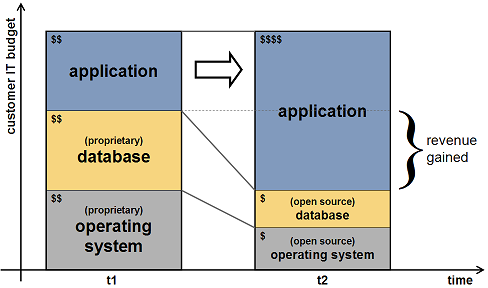On their blogs, Matt Asay and Savio Rodrigues are discussing whether IBM is using open source to diminish competitor margins. I think it is obvious that IBM does this, most notably with its Linux engagement, which is squarely directed against Microsoft (Windows). It is what I call a war over the share of customer’s wallet, and open source plays a major role. The graph below shows how it works.

By “share of wallet” I mean the amount (percentage) of a customer’s IT budget that a vendor can get. Any IT user buys multiple different components, for example, operating system, productivity tools, and business applications, but ideally they only buy one of a given type. They only want one database, not many. So each IT vendor has two types of competitors: those that directly compete with their products, and those that offer ancillary products. You can take on your direct competitors through better sales or service or product. For ancillary products, you need a different strategy.
If you offer a business application, databases and operating systems are ancillary (complementary) product categories for you. You aren’t offering a product in that category, so you can’t make any money of it. You can, however, reduce the amount of money that these other products take out of a customer’s IT budget (wallet) and then convince the customer to spend that extra money on your product. So what you want is to shift money from one component in the solution stack to another component, specifically to the one you are offering.
How do you do this? Well, you diminish the margins of the components that are ancillary to your product, as Matt rightfully points out. Look at the figure above. If you can make the customer spend less money on the database and operating system, then you can possibly gain that money for the application component. So, if you are an application provider, you may want to invest in open source solutions for database and operating systems, if they are cheaper than the leading proprietary solution (which they typically are). This leaves more money on the table for your application.
I think that’s the open secret behind IBM’s Linux engagement. By ensuring that there is a viable competitor to Windows, at least on the server, IBM is keeping Microsoft’s pricing in check, leaving more money to be spent on other software packages. Is there anything wrong with it? Not really, it is just competitive strategy, to the benefit of the customer in this case.
If you want to hear or read more about this, you can turn to an earlier article which discusses the share of wallet wars or catch me next at Agile 2008, where I will be talking about this too.









Leave a Reply